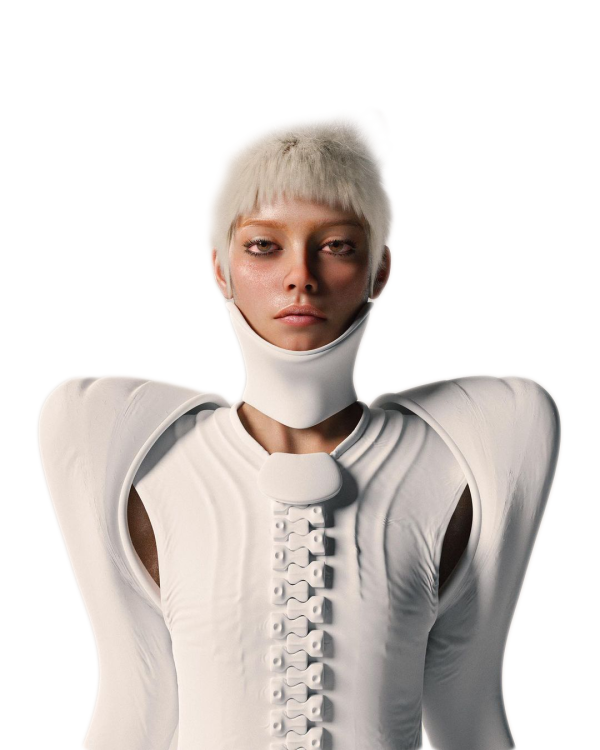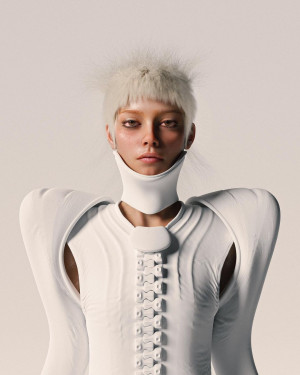

- Date
- 22 JUNE 2023
- Author
- DAVIDE ANDREATTA
- Image by
- GUILLAME SOUZIE
- Categories
- Interviews
Digital fashion and the relief from physical constraints. An interview with Guillaume Sauzey
Guillaume Sauzey is an art director and visual artist boasting collaborations with fashion brands such as Adidas and Valentino Beauty.
A vivid imagination and an experimental approach to digital fashion distinguish his creative process: in all of his designs intricate patterns meet playful color schemes and scenarios.
He is represented by Braw Haus, a studio working at the forefront of digital art, NFTs, 3D fashion and the metaverse.

Guillame, how would you introduce yourself to Red Eye’s community?
My name is Guillaume Sauzey (Soze) and I come from the south of France. I currently live between Paris and Biarritz.
I'm an art director and visual artist who likes to create weird 3D fashion stuff.
I did some research and I’ve read that you picked up 3D quite recently which is astonishing when one starts to consider your accomplishments and the complexity of your work. How did you start with 3D? Was any particular element or condition responsible for such a fast learning curve?
Yeah I started 3D (by mistake) in March 2021.
But I’ve been using music softwares (Ableton) since when I was 12 years old; I was heavily invested in music throughout my adolescence. The thinking process isn't exactly the same but I think this interest and all the skills coming with it helped me a lot.
I started to learn more about visual softwares and became acquainted with the entire Adobe Suite. At the time I worked as an Art Director in advertising but it was really boring. In March 2021, I worked for an advertising agency as an art director, and I had to produce models for Bungie, the video game studio. The studio didn't want to send us the requested 3D assets, so I had to produce them myself 3D – having no 3D basis. After a few weeks and a few sleepless nights, I really got a taste for it, and today I want to thank them for not providing us with these assets!

In your view, what are the reasons beyond fashion’s recent infatuation for digital art? Obviously there is progress in technologies like AI or AR and the development of the metaverse, but do you believe there is something larger at play here?
Technological progress now allows anyone with a computer to create 3D stuff (or AI/AR) even with a low end computer. Nowadays, some people buy clothes just to show them on Instagram, which is something I find completely stupid.
Digital fashion makes it possible to counter this heresy by offering 3D clothing, providing at the same time a more creative approach to fashion, by relieving physical constraints for example.

Continuing with the previous point: what is the relation between digital fashion and sustainability? On one hand it can be a response to the criminal amount of waste that the fashion system produces, on the other it still requires an incredibly complex infrastructure to work and to process data: what does sustainability look like in the digital sphere?
The pollution generated by the textile industry is huge. As of now, it is the second most polluting industry in the world. And fast fashion is only making things worse. This is why solutions must be urgently found and digital fashion might be one of them, allowing people to express their creativity on social media platforms, while limiting their environmental impact.

You boast an incredible list of collaborations with huge fashion brands: what’s the most exciting project you’ve been a part of?
To this day I think it still has to be the film realized in collaboration with Adidas. And I want to thank the Braw Haus Studio once again for involving me in the project. The most exciting element about it was the creative freedom that the brief granted us. Of course, there were a few inevitable constraints such as the placement of the different garments, shoes and accessories and also the film had to take place in Paris, but aside from that it allowed us to freely experiment. So we came up with this "Paris Playground" proposal, and 3 weeks later the film was done.

How do you see AI impacting the fashion industry? Will it disrupt it or move it forward? Maybe both?
As far as AI is concerned, I find it interesting as long as it remains a tool designed to support creation. However, there’s a concrete risk of it becoming omnipresent and replacing artists and this is something we need to be aware of. We are only in the early stages of AI and I can't wait to see how it will evolve in the future: I just hope that we don't all become stupid serial prompters without any creative vision or technical knowledge.
